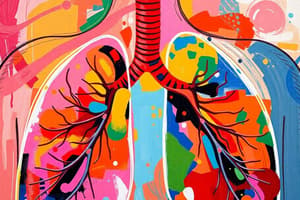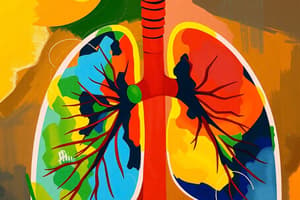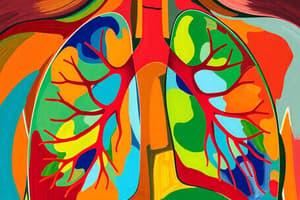Podcast
Questions and Answers
What is being measured by the tidal volume?
What is being measured by the tidal volume?
- The ease of expansion of the lungs.
- Amount of air exhaled after maximal inhalation.
- The pressure applied by a ventilator.
- Air moving in or out during breathing. (correct)
What does 'vital capacity' measure?
What does 'vital capacity' measure?
- The amount of air remaining in the lungs after normal exhalation.
- The volume of blood that is pumped out of the heart in one minute.
- The capacity of the heart to pump blood.
- The amount of air exhaled after maximal inhalation. (correct)
What happens to lung function as pressures rise, affecting lung compliance?
What happens to lung function as pressures rise, affecting lung compliance?
- Lung function becomes easier to measure.
- Lung function improves.
- Lung function is worsening. (correct)
- Lung function remains stable.
What is the normal partial pressure of oxygen (PO2) in the mixed venous blood?
What is the normal partial pressure of oxygen (PO2) in the mixed venous blood?
What is the approximate partial pressure of carbon dioxide (PCO2) in the end capillary?
What is the approximate partial pressure of carbon dioxide (PCO2) in the end capillary?
What does lung compliance on ventilation refer to?
What does lung compliance on ventilation refer to?
What is a key effect of decreased compliance due to surfactant deficiency?
What is a key effect of decreased compliance due to surfactant deficiency?
Which of the following is a factor that affects surfactant production?
Which of the following is a factor that affects surfactant production?
What is a consequence of increased alveolar-capillary membrane thickness?
What is a consequence of increased alveolar-capillary membrane thickness?
What process is directly affected by emphysema?
What process is directly affected by emphysema?
What is the approximate time required for diffusion of O2 and CO2 to reach equilibrium?
What is the approximate time required for diffusion of O2 and CO2 to reach equilibrium?
What happens to total lung surface area (SA) with aging?
What happens to total lung surface area (SA) with aging?
What does perfusion refer to?
What does perfusion refer to?
Which circulatory system includes the lungs?
Which circulatory system includes the lungs?
Adequate Cardiac Output (CO) is dependent on proper functioning of which system?
Adequate Cardiac Output (CO) is dependent on proper functioning of which system?
Which of the following is true regarding gravity and gas exchange?
Which of the following is true regarding gravity and gas exchange?
What is the normal ventilation/perfusion (V/Q) ratio?
What is the normal ventilation/perfusion (V/Q) ratio?
Which of the following is true of ventilation in a 'shunt'?
Which of the following is true of ventilation in a 'shunt'?
In anatomic shunts, blood bypasses the alveoli, moving from the right to the left heart without:
In anatomic shunts, blood bypasses the alveoli, moving from the right to the left heart without:
Lung tissues affected by a shunt don't respond to oxygen (O2) therapy because:
Lung tissues affected by a shunt don't respond to oxygen (O2) therapy because:
What does pulmonary vascular resistance (PVR) represent?
What does pulmonary vascular resistance (PVR) represent?
Normal PaO2 levels are typically in what range?
Normal PaO2 levels are typically in what range?
A pulse oximetry reading (SpO2) of what percent is generally considered normal?
A pulse oximetry reading (SpO2) of what percent is generally considered normal?
Capnometry provides a numeric measurement of which gas?
Capnometry provides a numeric measurement of which gas?
What range of ETCO2 is considered an early warning sign for ventilation changes?
What range of ETCO2 is considered an early warning sign for ventilation changes?
Flashcards
Tidal Volume
Tidal Volume
Air moving in or out during breathing.
Vital Capacity
Vital Capacity
Amount of air exhaled after maximal inhalation.
Lung Compliance
Lung Compliance
How easily the lungs expand. Worsening function means increased pressure needed.
Perfusion
Perfusion
Signup and view all the flashcards
Systemic System
Systemic System
Signup and view all the flashcards
Pulmonary System
Pulmonary System
Signup and view all the flashcards
Cardiac Output (CO)
Cardiac Output (CO)
Signup and view all the flashcards
Exposure Length (Gas Exchange)
Exposure Length (Gas Exchange)
Signup and view all the flashcards
Shunt
Shunt
Signup and view all the flashcards
Anatomic Shunt
Anatomic Shunt
Signup and view all the flashcards
Capillary Shunt
Capillary Shunt
Signup and view all the flashcards
Shuntlike effect
Shuntlike effect
Signup and view all the flashcards
Venous Admixture
Venous Admixture
Signup and view all the flashcards
Pulmonary Vascular Resistance (PVR)
Pulmonary Vascular Resistance (PVR)
Signup and view all the flashcards
PaO2
PaO2
Signup and view all the flashcards
SaO2 and SpO2
SaO2 and SpO2
Signup and view all the flashcards
Normal Range PaO2
Normal Range PaO2
Signup and view all the flashcards
Capnometry
Capnometry
Signup and view all the flashcards
Capnography
Capnography
Signup and view all the flashcards
ETCO2 Monitoring
ETCO2 Monitoring
Signup and view all the flashcards
Colorimetric Capnography
Colorimetric Capnography
Signup and view all the flashcards
Minute Ventilation
Minute Ventilation
Signup and view all the flashcards
Inspiratory Capacity (IC)
Inspiratory Capacity (IC)
Signup and view all the flashcards
Total Lung Capacity (TLC)
Total Lung Capacity (TLC)
Signup and view all the flashcards
PS
PS
Signup and view all the flashcards
Study Notes
Pulmonary Mechanics
- Tidal volume refers to the air moving in or out during breathing.
- Vital capacity relates to the amount of air exhaled after maximal inhalation.
- Lung compliance worsens as pressures rise, requiring the ventilator to apply more pressure per breath.
Alveolar-Capillary Interface
- This is where gas exchange occurs between alveoli and capillaries.
- Unoxygenated blood flows from the right heart to the lungs, then back to the left atrium.
- PaO2 measures the partial pressure of oxygen in venous blood.
- PAO2 measures the partial pressure of oxygen in the alveoli where gas exchange is occurring.
Pulmonary Gas Diffusion Factors
- Lung compliance on ventilation is determined by the ease of expansion.
- Lung compliance is sensitive to conditions affecting lung tissues.
- Decreased lung compliance can result from surfactant deficiency.
- Surfactant helps alveoli open during inspiration and prevents collapse during expiration.
- Decreased surfactant increases the work of breathing and causes decreased tidal volume.
- Surfactant can be affected by premature birth, aging, smoking, ARDS, and acute lung injury.
- Aging impacts ventilation by flattening the diaphragm, stiffening the chest wall, weakening respiratory muscles, and increasing the anterior-posterior diameter.
- These age-related changes decrease lung compliance, alter pulmonary mechanics, and cause air trapping.
Factors Affecting Gas Exchange
- Lung surface area significantly impacts gas exchange.
- A greater alveolar-capillary membrane surface area allows for better gas exchange.
- Emphysema reduces the alveolar capillary membrane, decreasing surface area.
- Thinner membranes facilitate faster diffusion.
- Conditions that thicken the membrane include fluid in alveoli, interstitial spaces like pulmonary edema from HF or pneumonia, inflammatory processes, and lung fibrosis.
- Diffusion of O2 and CO2 needs 0.25 seconds to reach equilibrium.
- Blood flows through the alveolar capillary system in 0.75 seconds at rest.
- Increased CO decreases exposure time, resulting in hypoxemia.
- Sepsis induces elevated CO states.
- Aging reduces total lung surface area and increases alveolar-capillary membrane thickness.
- Destroyed alveoli, decreased diffusion, altered ventilation-to-perfusion relationship, and less efficient gas exchange also results from aging.
Pulmonary Perfusion
- Perfusion is the process of pumping blood to tissues and organs
- It is split into the systemic and pulmonary systems
- Oxygenation of body tissues needs sufficient perfusion in both systems
- The systemic system originates from the aorta and extends to the right side of the heart.
- The pulmonary system involves the pulmonary artery, from the right ventricle to the lungs and then left ventricle, which relies on adequate perfusion in the systemic system
- CO (4-8 L/min) = HR x SV
- The SV relates to ventricular preload, afterload, and contractility.
- Adequate perfusion relies on MAP (60 -100,
- Greatest gas exchange occurs in the bases, where gravity pulls blood towards.
- Normal ventilation-to-perfusion ratio (V/Q) is 4:5 (0.8).
- Greatest amount of gas exchange occurs in bases.
- Heart failure slows perfusion.
- Respiratory failure impairs ventilation.
- Alterations in ventilation-perfusion ratio from diseases can cause unoxygenated blood to return to the left side of the heart, leading to hypoxemia.
Shunt Considerations
- Shunt is the percentage of cardiac output that flows from the right heart to the left heart without undergoing pulmonary gas exchange, a main cause of hypoxemia in high-acuity patients.
- True shunts can be anatomical or capillary.
- Anatomic shunts involve blood moving from the right heart to the left heart without contacting the alveoli and is a result of bronchial emptying, and abnormal blood flow from heart or lung problems
- Capillary shunts involve normal blood flow past completely unventilated alveoli because of consolidation, atelectasis or fluid.
- Shuntlike effects occurs if ventilation is reduced, but not absent with alveoli still functioning, results in alveoli can be affected by O2 therapy
- Shunting 15%+ CO equates to severe respiratory failure, and 30% or great usually constitutes ARDS.
- Hallmark of ARDS is Refractory hypoxemia.
- With venous admixture, oxygenated blood mixes with partially oxygenated blood, and this creates a new pressure balance.
- Resistance to blood flow in the pulmonary vascular system signifies right ventricular afterload.
- PVR is affected by vessel length, radius, and blood viscosity.
Arterial Blood Gases
- PaO2 measures partial pressure of oxygen in arterial blood.
- Normal PaO2 is 80-100 mm Hg.
- SaO2 indicates the percentage of O2 bound to hemoglobin.
- Normal values are above 95%.
- Normal hemoglobin levels are 12-15 g/dL for women and 13.5-16 g/dL for men.
- ABGs provide information on acid-base balance and oxygenation status.
- Normal ABG occurs at sea level with 21% oxygen, and normal blood temperature.
- At ages 30-80 there is a 25-30% decrease in PaO2.
- Mild hypoxemia: PaO2 60-75 mm Hg
- Moderate: PaO2 45-59 mm Hg
- Severe: PaO2 less than 45 mm Hg
- Normal pH range: 7.35-7.45
- Normal PaCO2 range: 35-45 mm Hg
- Normal HCO3 range: 24-28 mEq/L
- Normal BE range: +/- 2 mEq/L
Capnography
- Capnography, also known as end-tidal CO2 monitoring, is a noninvasive graphic display of CO2 concentration exhaled by the patient during breathing, which is displayed by a capnogram.
- Capnography can monitor ventilation, post-op recovery and PCA's, ED's or ICU's.
- ETCO2 monitoring assesses ventilation with normal range between 30-44.
- Abnormally low ETCO2 levels can relate to hyperventilation, hypothermia, PE, or decreased CO
- Elevated ETCO2 relates to increased CO2 production or hypoventilation.
- Inaccurate results can stem from morbid obesity, severe pulmonary edema, and ventilation-perfusion abnormalities or from a mis-positioned ET tube as capnography is not precise for ET placement.
- Colorimetric capnography uses pH-sensitive paper that changes color based on exhaled CO2 levels.
- Minute ventilation is the total volume of expired air in one minute and calculated: VE = TV x frequency. with a normal range of 5-10 L/min
- Respiration takes place on a cellular level, involving the exchange of Co2 and O2 across a semipermeable membrane.
- Ventilation provides air in and out of the lungs to maintain ABG's.
Studying That Suits You
Use AI to generate personalized quizzes and flashcards to suit your learning preferences.




